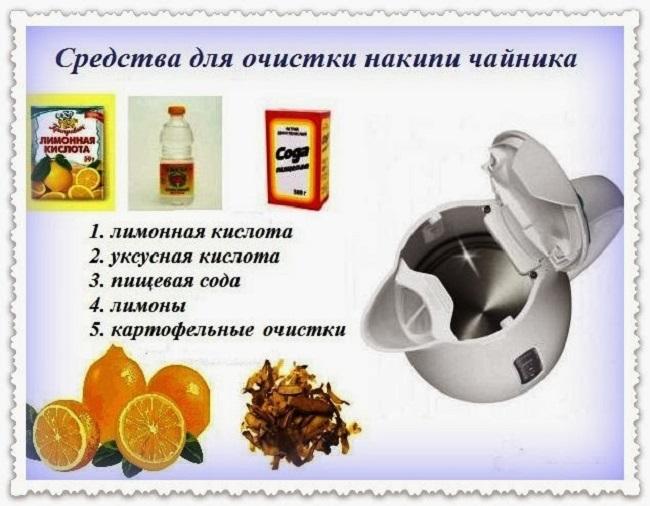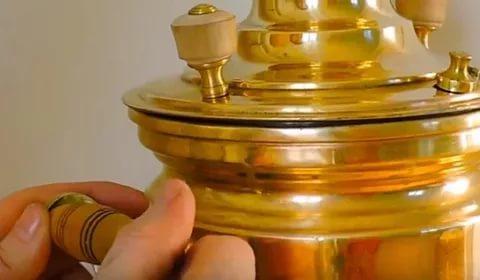How to descale a samovar at home
The samovar must be regularly cleaned from the inside and rubbed to a shine on the outside. Limescale deposited during boiling water reduces thermal conductivity and leads to overheating and destruction of the furnace walls. The taste of the drink deteriorates, the aroma is lost. To prevent this from happening, you need to choose a suitable method for descaling.
Descaling methods
Scale gradually forms from hard water in the samovar
Plaque appears from hard water. The water filter will soften the water and the limescale layer will become thinner. But it will not completely solve the problem, so you need to find the right cleaning agent. First, you need to determine the age of the samovar and the material from which it is made - it depends on how to remove plaque.
Store drugs
They will remove scale from the walls without damaging the surface of the flask made of any material, such preparations:
- Cinderella;
- Shine;
- Adepinka;
- Anti-scale and others.
Regardless of the design of the samovar - electric, coal, wood-fired - you should buy a tool for teapots. Scale is formed when water is boiled from the salts it contains; it is the same inside any dish.
Each package describes in detail how to use the product and in what quantities. Violating the instructions is possible only in the direction of decreasing concentration. You will have to clean the plaque in the samovar again, but there will be a full guarantee that the surface of the flask will not be damaged.
Do not use substances that are intended to be cleaned of salts from dishwashers and washing machines.
Traditional methods

The samovar can be cleaned using the same folk methods as the kettle.
Do not clean the walls with knives or hard objects. From them, scratches form on the surface, and the metal of the flask will begin to quickly collapse.
Substances that will help remove limescale:
- Lemon juice contains a lot of acid, and its peel contains a large amount of essential oils and alcohols, which destroy calcareous compounds. A thin layer of plaque can be easily removed by boiling water with a few lemon wedges for 20 minutes.
- Glycerin should be added to water at the rate of 8-10 drops per liter of boiling water. Soak for 3 - 5 hours, drain the water and wipe the walls with burlap or other natural cloth with a large weave of threads. You can use a sponge with a rough side.
- Potato peels or potatoes. You need about 1 kg of product. The tubers need to be washed well, cut into thin slices, put into a samovar and filled with water. Boil for 25 - 30 minutes, then leave the liquid in the samovar for another 3 - 4 hours or overnight. Then pour out the contents and wipe the inside of the walls.
- Apples - in their skins, acids are useful for descaling. Cleaning can be done during the period of harvesting jam for the winter or take fruits of sour varieties, use unripe fruits. Peel the apples first and add the missing amount of peel with thin circles. Do not use the middle. Remove limescale with them in the same way as with potatoes.
- Citric acid is commonly used to clean kettles, washing machine and dishwasher heating elements. In samovars, it acts mildly, destroying carbonate salts and without damaging copper and brass. Removes even thick layers of limescale. Pour water into the samovar and heat to about 80 ° C. Pour and stir a small pack of citric acid, about 30 g. Bring water to a boil and leave for 2 - 3 hours. Drain off the water - most of the salts will be removed by themselves, the remains can be easily removed with a wooden or plastic spatula, a rough sponge. If sediment remains, repeat the procedure again.
- Vinegar is diluted to an acid concentration of 2 - 3%. Pour hot water into the samovar or heat it up. Add a glass of white vinegar per liter of volume, and if using essence, then 2 - 3 tbsp. spoons. Boil and stand hot for 20 minutes. Drain the contents and wipe off any scale residues with a sponge.
- Vinegar and baking soda. Soda acts on carbonate salts, softening them. Vinegar completely destroys crystals. Boil water and dissolve soda in it at the rate of 10 - 15 grams per liter. Stir until completely dissolved. Boil for 20 - 25 minutes and drain the solution. Fill the samovar with boiling water and add 9% white vinegar to it at the rate of 50 ml per liter of flask volume. Boil for 15 - 20 minutes, let stand until cool and drain. Rinse with clean water and remove any remaining limescale deposits.
- You can clean the samovar from salt deposits with vinegar alone. It is enough to mix it with water in a ratio of 1: 3 and pour it into a flask. Boil for 25 minutes and leave for 4 - 6 hours. Vinegar can be replaced with oxalic acid and hydrochloric acid by making a 3% solution.
- Coca Cola contains a large amount of phosphoric acid and sugar. The drink is poured into a samovar, brought to a boil. Pour the mixture and remove plaque inside after 6 to 8 hours.
- L - brass;
- M - copper.
- ammonia - 30 ml;
- water - 200 ml;
- tooth powder - 20 gr.
- coarse salt;
- vinegar;
- flour.
You cannot drink tea immediately after cleaning with any means. It is necessary to boil the water in it again and drain it to remove the remaining cleaning agent.
Traditional methods are not as effective as special purchased ones. But they do not contain substances harmful to human health. They can be used when the samovar plaque is thin and cleaned regularly.
How to polish a samovar to a shine

Before cleaning the samovar, handles and other small parts must be removed
Coal and firewood leave soot and soot on the inner walls of the furnace. They should be removed to improve heat transfer and reduce the amount of soot escaping. Before cleaning the entire samovar, soot must be removed. To avoid excess dirt, first collect the base layer with a damp newspaper. Then apply baking soda or shavings of laundry soap on a damp sponge and wipe the inner walls of the firebox. Finally, rinse everything off with warm water.
Before the first cleaning of an old unit, you should determine the material from which it is made. Stainless steel has a characteristic metallic color. Samovars with a yellow tint should have a stamp and pay attention to the letter:
If there is no marking, you need to focus on the shade. The copper is dark, reddish. Golden yellow bronze. Light patina - dark spots, emphasizes the ancient origin of the utensils. Green and black streaks must be removed.
Before you wash the flask from dirt, the samovar should be disassembled. It is necessary to remove the crown, handles, faucet, key and stand from it. Soak all parts in a baking soda solution to make it easier to clean. Then it is necessary to wash off the coating of grease and dust from the surface with ordinary dishwashing detergents.
A brass samovar will clean up a homemade mixture:
Mix everything and apply with a sponge to the surface of the flask. Then wipe dry with a coarse calico or linen napkin and rub the samovar.
For copper utensils, a different composition is suitable:
Mix the components in equal proportions, moisten a napkin in the composition and rub the sides of the samovar with it until it shines.
It is best to clean stainless steel kitchen items with oven cleaner. Only gels can be used. Do not use abrasive and acidic substances.
Pastes are universal for all metals: Goy and tooth. They are spread on a damp cloth and the surface of the samovar is rubbed until it shines. Rinse off the residues with warm water. Goyi is finely dispersed polishing. It is green. The cheapest toothpaste is suitable, white, no additives.
In the old days, samovars were rubbed with river sand and powdered stone. After that, they quickly lost their appearance due to the formation of a large number of scratches.

